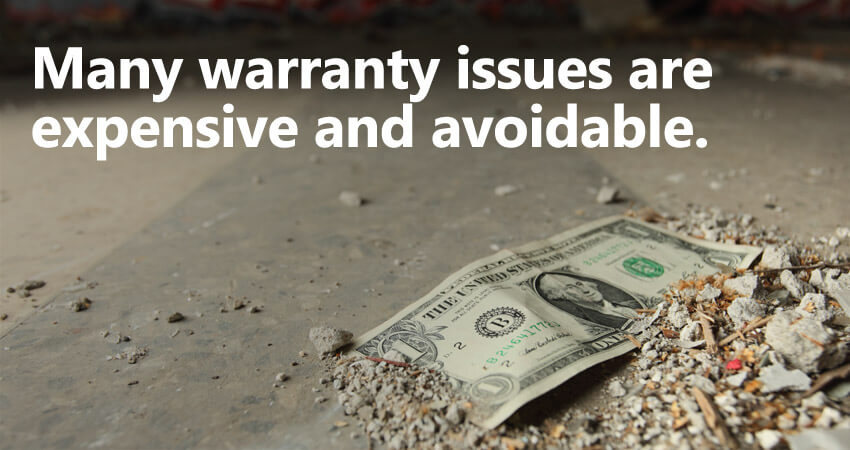Every new building has a Warranty Period, which serves as a guarantee for its quality. To minimize the risk of costly issues during this period, it is crucial for builders to prioritize quality control, quality assurance, and quality management throughout the construction process. By ensuring that the project is built correctly from the start and implementing effective measures for quality control, quality assurance, and quality management, builders can mitigate the likelihood of future warranty problems. However, in the event that warranty claims do arise, it is essential for builders to be organized and prepared to address and resolve them promptly.
A Quality Control System is the inherent organization tool in the building system. Its primary function is to provide the Builder a framework to achieve first time quality in every stage of construction, from slab through final inspection. After a project closes, the QC System provides a secondary function to reduce warranty defects.
On the surface, warranty issues are often attributed to construction errors. However, upon closer inspection, a significant portion of these issues can be traced back to variations in the manufacturing or business process and a failure to meet the quality requirements. It is crucial to identify these deviations from standard best practices and prevent their recurrence. To accomplish this, warranty claims should be reconciled within the quality control process.
Every error or defect can be traced back to a specific construction phase, activity, and subcontractor. In order to ensure quality and minimize such issues, it is important to have quality control specialists who focus on statistical quality control and monitor the manufacturing processes. These specialists play a crucial role in identifying trends and "hot spots" where recurring issues occur throughout the construction process. These hot spots raise important questions about the reasons behind warranty claims during specific construction phases or activities. It is essential for both the subcontractor, who should promptly address warranty issues, and the builder, who should analyze these trends, to work together and improve the overall quality of the construction process.
Answering that question, the Builder will often find variation to blame. (i.e. Separate crews frame the home slightly different, different materials are used, plan details are interpreted differently, etc.) There may be deviations from the Builder’s standard best practice. Or there is no best practice, and one needs to be established. Regardless, all that variation results in varying levels of quality in the completed project.
When a Hot Spot is identified, the Builder must establish a QC inspection at that construction phase or activity. These inspections define the expectation for what material is used, how those materials are installed and how the craftsmanship is to be executed and completed. Inspections evaluate the completed work and confirm it meets the builder’s expectation.
To effectively reduce warranty issues, it is crucial to have a quality control inspector overseeing the QC process. This inspector must perform inspections at the same point on every single home or project. Random or spot checking undermines the purpose of quality control and leads to inconsistencies. Both Construction Manager A in the north community and Construction Manager Z in the south community should adhere to the same inspection process. Consistency across managers helps eliminate variation and ensures a predictable level of quality for every home. Recognizing the importance of quality control is vital in maintaining desired outcomes.
While quality control inspections by a certified quality inspector evaluate conformity, variation is best eliminated when the work is actually performed on the production line. Quality control requires the use of QC checklists, which provide clear, concise steps to ensure consistent performance on every project. These checklists also serve as completion reminders for the crew to double-check before leaving the jobsite. What's more, QC checklists are replicable across jobsites, allowing for standardized expectations regardless of whether it's Crew A or Crew Z carrying out the work.
Finally, the Builder must monitor the QC system. Inspections provide data and production intelligence that indicate the quality delivered in each phase within the construction process. This allows the Builder to make corrections in the field before errors turn into escalated warranty issues—ones that involves multiple homes or an entire community. Monitoring and analyzing the inspection data also gives the Builder a broader understanding of how subcontractors are performing.
Many warranty issues are expensive and avoidable. A progressive Builder can utilize its QC System to prevent errors from occurring in the first place, and remove recurring defects from its building process all together. No crystal ball needed.
